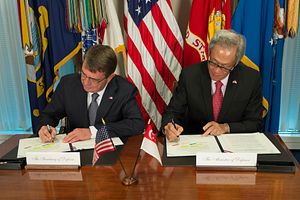Asia needs to craft regional rules and norms to defuse lingering tensions and safeguard the stability which has undergirded its prosperity, Singapore’s defense minister stressed at a security conference in Malaysia this week.
In his address at the 4th Putrajaya Forum in Kuala Lumpur – a biennial defense meeting – Defense Minister Ng Eng Hen said that ASEAN must work with its partners to strengthen the security architecture in the face of regional challenges.
“[W]e need to come together to create and abide by a common set of mechanisms, protocols and norms that guide behavior in this region. This will help to defuse tensions as well as reduce the risks of miscalculations and mistakes,” he said.
Ng emphasized the need for the ASEAN Defense Ministers’ Meeting (ADMM) and the expanded ADMM-Plus, which includes the ten countries in ASEAN along with eight dialogue partners – Australia, China, India, Japan, New Zealand, Russia, South Korea and the United States – to adhere to a set of commonly agreed goals and principles. As I’ve noted previously, the ADMM is emerging as the premier venue for defense and security issues in the region.
One of the key goals for the ADMM, Ng argued, would be to create and abide by a common set of mechanisms, protocols and norms to guide behavior in order to defuse tensions and reduce the risks of miscalculation.
Ng offered several examples of how this could be achieved, many of them ones that Singapore and other regional states have previously called for. First, he proposed quickly concluding a binding code of conduct (CoC) on the South China Sea between China and the ten members of the Association of Southeast Asian Nations (ASEAN), which he said government leaders agreed was “the most important deliverable” to reduce tensions there.
But while other initiatives like the CoC are being worked out, Ng said, it is important to keep the channels of communication open. As an example, he highlighted the recent direct communication link (DCL) initiative championed by Brunei, which seeks to establish a hotline between ASEAN states to enable them to communicate quickly and securely in a crisis situation and prevent unintended incidents in the high seas (See: “ASEAN Sets Up New Hotline Amid South China Sea Tensions”). The idea, Ng said, is to eventually expand DCL to include not just ASEAN states but the so-called Plus countries.
Ng also references several other proposals, most of which Singapore had already floated publicly. For instance, he reiterated the suggestion made at various fora including the 3rd ADMM Plus that the Code for Unplanned Encounters at Sea (CUES) – a series of protocols for the safety of naval vessels negotiated at the Western Pacific Naval Symposium back in 2014 – should be expanded to include white shipping, coast guards and fishing vessels (See: “Singapore Wants to Defuse South China Sea Tensions With Naval Protocol”).
He also mentioned creating a code of conduct to guide submarines on maneuvering to prevent accidents during an unexpected encounter. Though he did not elaborate, this too has been a growing focus for Singapore as well as other Asian states. For instance, as I outlined in a previous piece, Singapore’s navy chief Rear Admiral Lai Chung Han had outlined a four-part framework for submarine rescue the Asia-Pacific Submarine Conference back in May 2015 (See: “A New Plan to Tackle Asia’s Submarine Race?”).
Lastly, Ng offered that the region could also establish rules of behavior to regulate air encounters between military aircraft, similar to the ones established between the United States and China last September.
Strengthening the regional security architecture through such initiatives, Ng emphasized, will be key to sustaining the growth and prosperity that Asia has experienced over the past few decades.
“Our region has enjoyed substantial growth and prosperity for the past decades and it continues to demonstrate tremendous potential and promise,” Ng said. “To keep it that way, ASEAN must work together with other partners to strengthen our regional security architecture.”

































